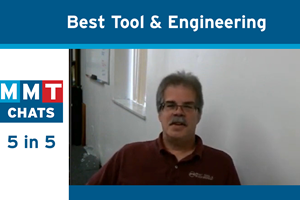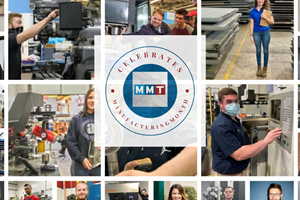Pre-Machining Best Practices for Industry 4.0
Emphasis on technology that streamlines processes and provides repeatable outputs in your machining operations is key to automation and data-driven intelligence. Here are some common pre- and in-process attributes to consider as they pertain to process efficiency and reliability.
Total process reliability is all about controlling inputs to minimize variances during manufacturing, to achieve the desired outputs with as little deviation from one part to the next as possible. At the spindle, this means establishing best practices that center around the innate quality of repeatability.
For any given process, piece of equipment or tooling introduced during manufacturing, ask if it adds or subtracts potential variables to or from your machining process. If it adds variables, then it is adding potential deviations that will make it more difficult to achieve automation and lights out machining.
So what kinds of quality attributes should be considered and what types of processes or products should be considered to maximize the repeatability of those desired attributes. The following are some of the most common pre-and in-process attributes Haimer USA suggests one considers, as they pertain to process efficiency and reliability.
- Pre-machining Tool Inspection. The most common inhibitors in properly detailing dimensions such as gage length, tool stick out, diameter, runout and insert height is time to measure, accuracy in measurement taken and errors in transferring offsets accurately to machine controls. Each can be measured any number of ways. However, using a presetter for such processes is the ideal methodology, as it saves significant time during the set-up process, while helping to eliminate errors and improve repeatability of machining operations. A presetter that has a high degree of accuracy to attain precise measurements is fundamental, but also look for one that has a stable construction that limits variances in temperature on the shop floor that can affect the repeatable accuracy of the machine. RFID or post-processing technology is also another important consideration to enable automated data transfer from presetter to machine control. These features eliminate possible errors in manual data transfer, such as miss-typed key strokes at the control. Lastly, ease of use for presetting machines cannot be understated. Machines with complex software and operating instructions often garner less than full adoption by users, thereby becoming very expensive paperweights over time.
- Runout. Runout accuracy is a quality that every shop knows is fundamental to any machining operation. Precise runout accuracy dictates outputs including dimensional part accuracy, surface finish, tool life and ultimately metal removal rates. A facet of runout often overlooked though is the ability to maintain TIR repeatedly over the course of a week, month or year. To ensure runout is precise and repeatable, look to employ toolholding solutions with as few wearable components as possible. For example, collet chuck systems employ a series of elements that must be put together to form the assembly. External variables like dirt, chips, and natural collet wear via over-tightening all lead to degradation of runout accuracy over time. In contrast, solutions like shrink fit holders offer the same or better precision versus this and other mechanical chucks, but lack the wearable components that impact TIR over time. With no moving or wearable mechanical parts, shrink fit is an ideal solution to achieve long-term repeatable runout accuracy, regardless of the operator or tool room attendant.
- Balance. Balance of tooling assemblies is critical in maintaining consistent and stable finishes, tool life, part accuracy, spindle life and productivity. Often when unbalance is present, cutting speeds are reduced to compensate for a myriad of issues the subsequent vibration unbalance creates. And while purchasing “balanced” tool holders is a good start, there are still too many variables when holders are assembled that can affect the final balance of the assembly. The factory of the future will need to integrate balance inspection technology as part of their pre-machining inspection processes. Unbalance simply leads to so many different potential problems, all of which affect the repeatability of any given machining operation. Inspecting assemblies prior to placement in the machine can reduce variances in the machining process by as much as 50%.
- Tool security. Tool security seems like perhaps the most obvious of attributes needed to maintain process reliability during machining. However, all too often things like slow metal removal rates, poor tool life and tool breakage are often blamed on the cutting tool instead of the true source of the problem. With newer and more aggressive machining toolpath strategies being employed every day, in combination with more advanced milling machines and cutting tools, the issue of micro-creep is becoming more and more prevalent in today’s machining environments. Instead of older side lock technology, look to newer anti-pullout solutions like Safe-Lock to garner total process security without sacrificing balance and runout accuracy.
Related Content
MMT Chats: 5 in 5 with Best Tool and Engineering
MoldMaking Technology Editorial Director Christina Fuges reveals 5 best practices for improving efficiencies within shops...in 5 minutes. Our guest is Joe Cherluck, President of Best Tool and Engineering in Clinton Township, Michigan. This episode is brought to you by ISCAR.
Read More2021 30 Under 30 Honors Program: Mentoring in the Next-Generation of Moldmaking Professionals
Young professionals are vital to the moldmaking industry, and it is important to acknowledge those making strides in shaping the industry's future. MoldMaking Technology recognizes the industry's young talent through its 30 Under 30 Honors Program.
Read MoreQuestions and Considerations Before Sending Your Mold Out for Service
Communication is essential for proper polishing, hot runner manifold cleaning, mold repair, laser engraving and laser welding services.
Read MoreMMT Chats: Marketing’s Impact on Mold Manufacturing
Kelly Kasner, Director of Sales and Marketing for Michiana Global Mold (MGM) talks about the benefits her marketing and advertising, MGM’s China partnership and the next-generation skills gap. This episode is brought to you by ISCAR with New Ideas for Machining Intelligently.
Read MoreRead Next
Reasons to Use Fiber Lasers for Mold Cleaning
Fiber lasers offer a simplicity, speed, control and portability, minimizing mold cleaning risks.
Read MoreHow to Use Continuing Education to Remain Competitive in Moldmaking
Continued training helps moldmakers make tooling decisions and properly use the latest cutting tool to efficiently machine high-quality molds.
Read MoreHow to Use Strategic Planning Tools, Data to Manage the Human Side of Business
Q&A with Marion Wells, MMT EAB member and founder of Human Asset Management.
Read More








.jpg;maxWidth=300;quality=90)








_300x250 3.png;maxWidth=300;quality=90)








